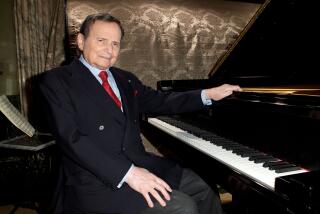Jerome Karle dies at 94; Nobel winner in chemistry
When Jerome Karle learned he was to share the Nobel Prize in chemistry, the Brooklyn-born scientist was miles above the Atlantic Ocean and quite unaware that his flight was about to turn into a champagne fete.
Karle had left his hotel room in Munich, Germany, before he could receive the news from Stockholm and was instead told by the pilot, who informed the entire aircraft and invited all to toast the passenger in seat 29C.
“It will take at least 24 hours for this to sink in,” Karle told reporters after his arrival in Washington, D.C.
Indeed, it had taken decades for Karle’s work to sink in with the scientific community. Initially, many scientists were puzzled by and skeptical of the methods and mathematical formulas he had used to describe crystal molecules after bombarding them with X-rays. By the time he and his colleague, mathematician Herbert A. Hauptman, were awarded the Nobel in 1985, their technique had been used to study poisons, heart drugs, antibiotics, anti-carcinogens, anti-malarials, explosives and propellants.
Yet until Karle’s death from liver cancer June 6, in Annandale, Va., the 94-year-old had hoped to see a third collaborator recognized: his chemist wife, Isabella.
Karle and others have credited Isabella with championing the practical applications of X-ray crystallography at a time when it was viewed as a theoretical curiosity. After learning of his Nobel, Karle told reporters that his wife also deserved the prize and hoped that she would one day receive the recognition. “I can’t think of anyone who is more qualified than my wife,” Karle said.
In the 1950s, Karle worked with Hauptman on developing the basic mathematics necessary to solve for crystal structures. Later, in the 1960s, Karle worked with his wife to develop general procedures for describing three-dimensional structures based on X-ray crystallography.
The process involves exposing a crystal to a beam of X-rays. As the X-rays move through the crystal, their course is altered, or diffracted, by individual atoms within the crystal. When the rays exit the crystal and strike a photographic plate, they leave a specific pattern. The pioneering work of Hauptman and the Karles allowed scientists to interpret these patterns in a way that gave them a view of how the atoms were arranged, and thus the three-dimensional structure of a molecule.
Molecules that took years to map with other methods could now be described in a matter of days. The process remains critical to determining the structure of large molecules and is used regularly in the pharmaceutical industry.
Karle was born June 18, 1918, to Louis Karfunkle, a Coney Island businessman, and Sadie Kun, an amateur pianist. Although his mother hoped that her son might become a professional pianist, Karle demonstrated an early interest in science and determined at a young age that he would make it his career.
He studied chemistry and biology at City College of New York. He then studied biology for a year at Harvard, earning his master’s in 1938. After a brief stint working in the New York State Health Department, he enrolled as a doctoral chemistry student at the University of Michigan, where he met Isabella Lugoski. They married in 1942.
In 1943, Karle went to work on the top-secret Manhattan Project at the University of Chicago. In 1946 he and his wife both joined the Naval Research Laboratory and maintained offices down the hall from each other until they retired in 2009. Each was awarded the Department of the Navy Distinguished Civilian Service Award.
Besides his wife, Karle is survived by three daughters: Louise Karle Hanson, a chemist, of Long Island, N.Y.; Jeane Karle, also a chemist, of Vienna, Va.; and Madeleine Karle Tawney, a geologist, of Lake Barcroft, Va.; and four grandchildren.
More to Read
Start your day right
Sign up for Essential California for the L.A. Times biggest news, features and recommendations in your inbox six days a week.
You may occasionally receive promotional content from the Los Angeles Times.







